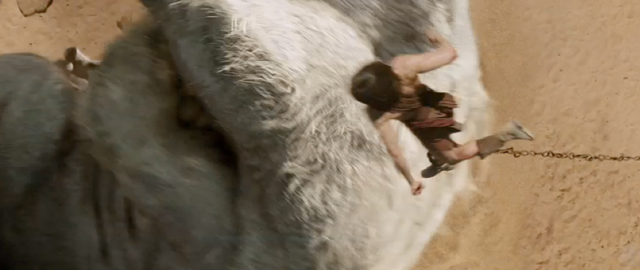Andrew Stanton’s sci-fi blockbuster John Carter is about a lot of things: It’s about deserting the Civil War only to encounter it again on Mars, it’s about mankind’s fascination with the Red Planet, and it seems to be at least a little bit about Jesus Christ. Mostly though, it’s about jumping.

Chart by Natalie Matthews © Slate.com
It’s hard to overestimate the amount of jumping in John Carter. On Mars, known in the movie as Barsoom, jumping is all anyone can talk about. John Carter’s Earth muscles turn out to be extraordinarily powerful in the low gravity sands of Mars, and the Martians just can’t get enough of it. “Sak!” they say, in the local Thark dialect, “Sak! Sak!” Soon, Carter is sakking all over the place, bounding across the dusty desert, and even leaping over a gargantuan “white gorilla.”
Awe-inspiring jumps have a long history in pop culture. Early incarnations of Superman in the 1930s and 1940s counted his ability to leap long distances among his most formidable powers (he didn’t yet fly). Superman creators Jerry Siegel and Joe Shuster seem to have been influenced by Carter in Superman’s creation, using similar logic to explain Superman’s extraordinary hopping abilities—a hopper on Krypton is a jumper on Earth. Other heroes and villains soon followed Superman’s lead, with Marvel’s Hulk and X-Men’s Toad first leaping across the pages of American comics in the 1960s.
But it was only when Hong Kong action cinema brought wire fu to Hollywood that action movie jumping really got off the ground. Filmmakers like director Tsui Hark and fight choreographer Yuen Woo-ping did stunning martial arts wire work in the 1980s and especially the 1990s (the wires are used to suspend the actors; they’re edited out in postproduction). The Matrix (1999) then made balletic wire kung fu a staple of Hollywood action films, with suspended mid-air kicks—and a crucial character development involving jumping from rooftop to rooftop. Star Wars Episode 1 (1999) had Jedis force jumping up several stories, but Ang Lee’s Crouching Tiger, Hidden Dragon (2000) had extended sequences of leaping across courtyards and through trees. Soon Woo-ping was working with Quentin Tarantino on the Kill Bill movies (2003 and 2004).

John Carter (Taylor Kitsch) jumps a “white gorilla” in the trailer for John Carter.
© The Walt Disney Company 2012
It wasn’t long, though, before wire acrobatics peaked then tumbled back to earth. In the Matrix sequels acrobatics went from stretching the laws of physics to breaking them entirely. The rules of the Matrix universe in the sequels allowed Neo to do anything he could think of, and CGI did the same for action choreographers. Neo flew off into the stratosphere. Meanwhile, heroes like Hulk (2003, also directed by Ang Lee) leapt from mountaintop to mountaintop in the Utah desert. The action no longer seemed to be grounded enough for most audiences, and jumping soon began to fall out of favor.
If it doesn’t make back its $250 million budget at the box office—reviews are mixed—John Carter might represent the spectacular last gasp of action movie jumping. John Carter’s jumping effects are the most realistic-looking in years, carrying the form to heights of believability previously unreachable, but the reliable moneymaker Jason Statham has lately been relying on the old-school athleticism and practical effects of the past. When John Carter finally leaps to the top of a tall building in a single bound, in one of that movie’s final set pieces—and you actually believe what you’re seeing—what you may be witnessing is the last true leap in action-movie jumping.